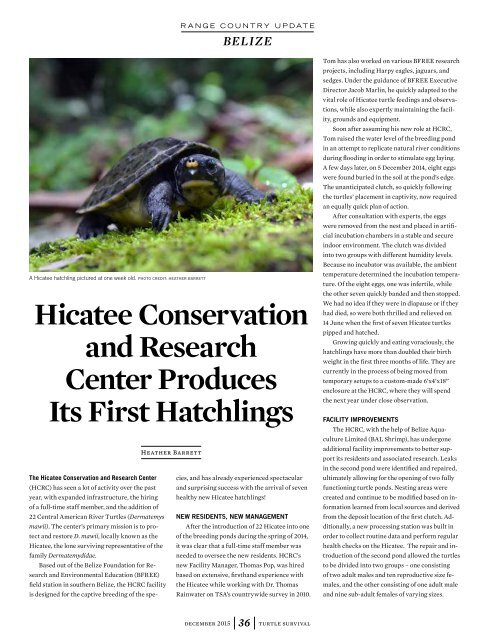Turtle Survival
2tUaeTbNi
2tUaeTbNi
Create successful ePaper yourself
Turn your PDF publications into a flip-book with our unique Google optimized e-Paper software.
RANGE COUNTRY UPDATE<br />
BELIZE<br />
A Hicatee hatchling pictured at one week old. PHOTO CREDIT: HEATHER BARRETT<br />
Hicatee Conservation<br />
and Research<br />
Center Produces<br />
Its First Hatchlings<br />
Heather Barrett<br />
The Hicatee Conservation and Research Center<br />
(HCRC) has seen a lot of activity over the past<br />
year, with expanded infrastructure, the hiring<br />
of a full-time staff member, and the addition of<br />
22 Central American River <strong>Turtle</strong>s (Dermatemys<br />
mawii). The center’s primary mission is to protect<br />
and restore D. mawii, locally known as the<br />
Hicatee, the lone surviving representative of the<br />
family Dermatemydidae.<br />
Based out of the Belize Foundation for Research<br />
and Environmental Education (BFREE)<br />
field station in southern Belize, the HCRC facility<br />
is designed for the captive breeding of the species,<br />
and has already experienced spectacular<br />
and surprising success with the arrival of seven<br />
healthy new Hicatee hatchlings!<br />
NEW RESIDENTS, NEW MANAGEMENT<br />
After the introduction of 22 Hicatee into one<br />
of the breeding ponds during the spring of 2014,<br />
it was clear that a full-time staff member was<br />
needed to oversee the new residents. HCRC’s<br />
new Facility Manager, Thomas Pop, was hired<br />
based on extensive, firsthand experience with<br />
the Hicatee while working with Dr. Thomas<br />
Rainwater on TSA’s countrywide survey in 2010.<br />
Tom has also worked on various BFREE research<br />
projects, including Harpy eagles, jaguars, and<br />
sedges. Under the guidance of BFREE Executive<br />
Director Jacob Marlin, he quickly adapted to the<br />
vital role of Hicatee turtle feedings and observations,<br />
while also expertly maintaining the facility,<br />
grounds and equipment.<br />
Soon after assuming his new role at HCRC,<br />
Tom raised the water level of the breeding pond<br />
in an attempt to replicate natural river conditions<br />
during flooding in order to stimulate egg laying.<br />
A few days later, on 5 December 2014, eight eggs<br />
were found buried in the soil at the pond’s edge.<br />
The unanticipated clutch, so quickly following<br />
the turtles’ placement in captivity, now required<br />
an equally quick plan of action.<br />
After consultation with experts, the eggs<br />
were removed from the nest and placed in artificial<br />
incubation chambers in a stable and secure<br />
indoor environment. The clutch was divided<br />
into two groups with different humidity levels.<br />
Because no incubator was available, the ambient<br />
temperature determined the incubation temperature.<br />
Of the eight eggs, one was infertile, while<br />
the other seven quickly banded and then stopped.<br />
We had no idea if they were in diapause or if they<br />
had died, so were both thrilled and relieved on<br />
14 June when the first of seven Hicatee turtles<br />
pipped and hatched.<br />
Growing quickly and eating voraciously, the<br />
hatchlings have more than doubled their birth<br />
weight in the first three months of life. They are<br />
currently in the process of being moved from<br />
temporary setups to a custom-made 6’x4’x18”<br />
enclosure at the HCRC, where they will spend<br />
the next year under close observation.<br />
FACILITY IMPROVEMENTS<br />
The HCRC, with the help of Belize Aquaculture<br />
Limited (BAL Shrimp), has undergone<br />
additional facility improvements to better support<br />
its residents and associated research. Leaks<br />
in the second pond were identified and repaired,<br />
ultimately allowing for the opening of two fully<br />
functioning turtle ponds. Nesting areas were<br />
created and continue to be modified based on information<br />
learned from local sources and derived<br />
from the deposit location of the first clutch. Additionally,<br />
a new processing station was built in<br />
order to collect routine data and perform regular<br />
health checks on the Hicatee. The repair and introduction<br />
of the second pond allowed the turtles<br />
to be divided into two groups – one consisting<br />
of two adult males and ten reproductive size females,<br />
and the other consisting of one adult male<br />
and nine sub-adult females of varying sizes.<br />
december 2015 36 turtle survival


